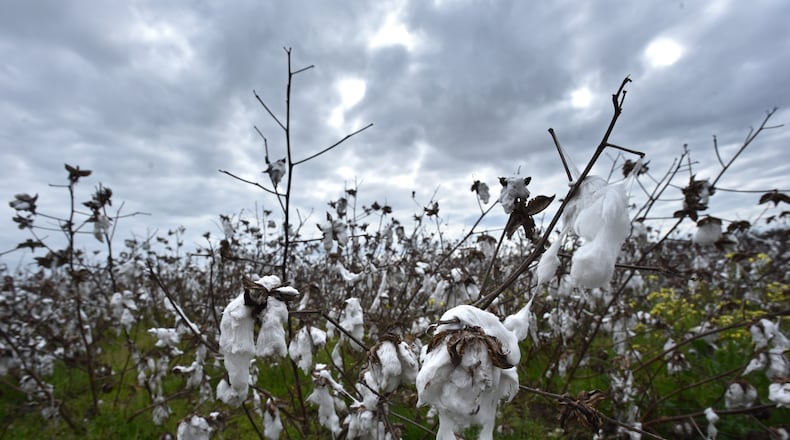On Tim Burch’s farm in Baker County, south of Albany, it’s not what he’s doing to prepare for the hurricane, it’s what he’s not doing. Burch, a peanut farmer, decided Monday morning to stop harvesting until after Hurricane Ian passes through.
“There’s really nothing else we can do,” Burch said. “Leave in the ground all the peanuts that aren’t dug or harvest all that you possibly can.”
Ian gained strength over the warm waters of the Caribbean and Gulf of Mexico, nearing Category 5 status before it slammed into Florida’s West Coast Wednesday afternoon with sustained winds of 155 mph. From there, the storm was expected to slog north up the Florida peninsula, before lashing southern Georgia and the Carolinas with tropical storm-force winds and heavy rain.
Damage to Georgia farms could be a significant drag on the state’s overall economy. In 2020, food production and related industries contributed $69.4 billion to the state’s $1.1 trillion economy and supported more than 350,000 jobs, according to the most recent analysis by UGA’s College of Agricultural and Environmental Sciences.
With memories of Hurricane Michael’s destruction fresh in mind, South Georgia farmers are keeping wary eyes on the skies.
Scientists say human-caused climate change melting the world’s ice caps and raising sea levels, increasing the destructive potential of storm surge. Warmer oceans can fuel the rapid intensification of storms, while rising air temperatures mean the atmosphere can hold more moisture, leading to more intense downpours.
In Georgia, the expected heavy rain and gusty winds come as some farmers begin their first week of fall harvest. Michael ripped through the Florida panhandle and southwest Georgia in 2018. Ian is on a different track, but could still bring devastation to Georgia’s coastal regions and much of the southern part of the state.
Taylor Sills, the executive director of the Georgia Cotton Commission, said that when the cotton plant is ready to harvest it becomes especially vulnerable to harsh weather conditions.
“That cotton is nice and fluffy,” Sills said. “And because it can be easily picked it can also be easily blown out by wind or knocked out by rain.”
Sills said his organization recommends farmers to, “harvest what’s possible, hope for the best but prepare for the worst.”
Burch, who also farms cotton, said he is hopeful that, given the path of the storm, the winds will be minimally detrimental to his crop although he is no stranger to the damages caused by a hurricane.
When Michael tore through southwest Georgia, Burch said he lost all the cotton that was ready to harvest at the time.
Sills estimated Georgia’s cotton industry lost 100 million bales as a whole or $300 million worth of the crop.
The storm also destroyed pecans, timber, chicken houses and more, causing an estimated $2.5 billion in damages to the state’s agriculture sector, according to analysis by the University of Georgia.
As Ian’s track has shifted east, growers in areas hit hard by Michael may avoid a repeat of 2018. But that doesn’t mean Georgia agriculture will escape this storm unscathed.
Farms in the southeastern part of the state are more likely to bear the brunt of the damage from Ian, said Pam Knox, an agricultural climatologist at UGA, with impacts similar to those caused by Hurricane Irma in 2017. Though Irma had been downgraded to a tropical storm by the time it reached Georgia, it still caused major damage on many farms and even in the metro Atlanta area.
Delayed federal disaster relief prolonged the effects of Hurricane Michael on many South Georgia farmers.
Some crops, like pecans, still have not recovered from the damage. For farmers who lost an entire pecan orchard in 2018, rebuilding their livelihood is not as simple as planting more pecan trees.
Samantha McLeod, the executive director of the Georgia Pecan Growers Association (GPGA), said pecan trees can take five to seven years to produce their first viable crop.
“Some farmers aren’t going to be able to reinvest in planting that orchard and tending to it with fertilizer costs and other input costs for the next five to seven years,” McLeod said.
McLeod said most pecan orchards in Georgia are not ready to harvest. This makes trees more susceptible to storm damage as their limbs are weighed down by a 100-200 pound load of pecans.
There isn’t much pecan farmers can do to protect their crop, although the GPGA is recommending they cease irrigation before the storm to firm up the soil, in hopes of stabilizing the trees.
“The Georgia Pecan Growers are really, really looking forward to a good crop and a good price this year. We have a lot of high hopes and we just really need to pull through this hurricane,” McLeod said.
If there’s any silver lining, it’s that farmers seem to have learned from recent storms and are working overtime to harvest what they can ahead of Hurricane Ian, potentially mitigating some losses, Knox said.
“I attribute that both to memories of how bad Irma and Michael were and better messaging of impacts way ahead of time, which gave them a window to go out and do the harvesting,” Knox said. “We had a lot less warning with Michael.”
A note of disclosure
This coverage is supported by a partnership with 1Earth Fund, the Kendeda Fund and Journalism Funding Partners. You can learn more and support our climate reporting by donating at ajc.com/donate/climate/
Keep Reading
The Latest
Featured



